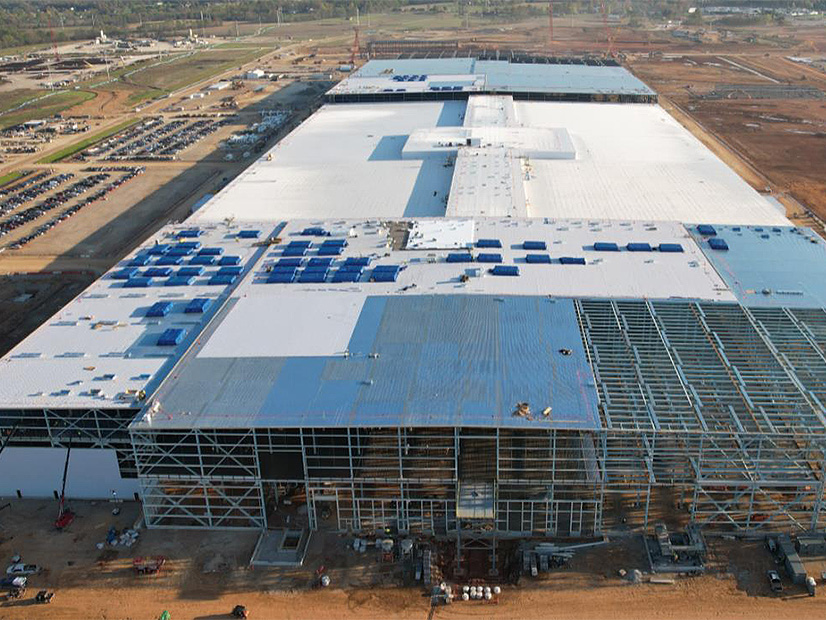
The Department of Energy’s Loan Program Office (LPO) on Thursday announced a conditional commitment for a loan of up to $9.2 billion to help BlueOval SK, a joint venture between Ford and Korean battery manufacturer SK On, to produce electric vehicle batteries at sprawling plants in Kentucky and Tennessee.
The three plants, one in Tennessee and two in Kentucky, will together be able to produce 120 GWh of batteries per year, to be used in Ford and Lincoln EVs, the LPO announced. Already under construction, the Kentucky plants cover an estimated 2.3 square miles, with battery production to begin in 2025, according to the BlueOval website.
With a 6-square-mile “megacampus,” the Tennessee plant will be the largest in Ford’s portfolio and include both battery manufacturing and a factory for Ford EVs, according to BlueOval. As described on the company website, the plant will “be carbon neutral, use 100% renewable energy, send zero waste to landfill and use fresh water only for human consumption ― as [Ford] moves towards a closed-loop manufacturing process.”
Production in Tennessee also is scheduled to begin in 2025, the company said.
Job creation across all three plants will be about 5,000 during construction, with 7,500 permanent positions. BlueOval is working with community colleges in Kentucky and Tennessee to develop training programs “where thousands of employees will gain the skills required to work at the battery plants,” according to the company announcement.
BlueOval will be building a training facility next to the Tennessee plant to “really [focus] on the curriculum for training, deep learning, and getting people through that part of the training before they come out on the shop floor to be a part of the launch,” said Kel Kearns, the plant manager, as reported by WBBJ in Jackson, Tenn.
The LPO noted that the Kentucky and Tennessee projects are also located near or in disadvantaged communities, reflecting President Joe Biden’s “Justice 40” commitment to ensuring 40% of all federally funded projects benefit low-income and disadvantaged communities.
“The DOE’s commitment to this project will strengthen battery manufacturing in the U.S. while reducing carbon emissions, providing customers with high-performance vehicles, and creating good jobs for future generations,” said BlueOval CEO Robert Rhee. The company must meet additional LPO requirements before the conditional loan can be finalized.
A Domestic Supply Chain
Building out a domestic supply chain for EV and stationary batteries is a key priority for the LPO, as domestic content in EVs and batteries has become a political flashpoint for Biden’s push to make electric vehicles 50% of all new car sales by 2030.
The industry is highly dependent on China for batteries and the processing of critical minerals in them, including lithium, cobalt and nickel. Sen. Joe Manchin (D-W.Va.) made a U.S. supply chain buildout a key part of the Inflation Reduction Act.
To be eligible for the full $7,500 EV tax credit in the IRA, a vehicle must meet domestic content and assembly requirements.
According to Internal Revenue Service guidelines, to receive the full credit, the final assembly of an EV must occur in North America. In addition, 40% of the critical minerals in the battery and 50% of other battery components must be sourced, processed or manufactured in the U.S. or in a country with which the U.S. has a free trade agreement.
The domestic content percentages go up each year, with critical minerals increasing 10% per year, up to 80% in 2027, while the battery component also will increase 10% per year, rising to 100% in 2029.
Some, but not all, models of Ford’s top EVs — the Mustang Mach-e SUV and F-150 Lightning pickup truck — qualify for the full credit, according to the company website.
The LPO received $3 billion from the IRA specifically for its Advanced Technology Vehicles Manufacturing (ATVM) program, an amount that can be used to provide up to $40 billion in loan authority, according to an online fact sheet.
The BlueOval announcement is the latest conditional loan from the ATVM program. This month, the LPO made a conditional commitment for an $850 million loan to KORE Power for an Arizona plant that will produce battery cells to be used in both EVs and grid-scale stationary storage. (See LPO Announces $850M Conditional Loan for Ariz. Battery Cell Plant.)
In March, the office also announced a $375 million conditional loan to Li-Cycle Holdings to develop North America’s first recycling facility for battery-grade lithium, to be located in New York. (See DOE OKs $375 Loan for NY Battery Recovery Plant.)


